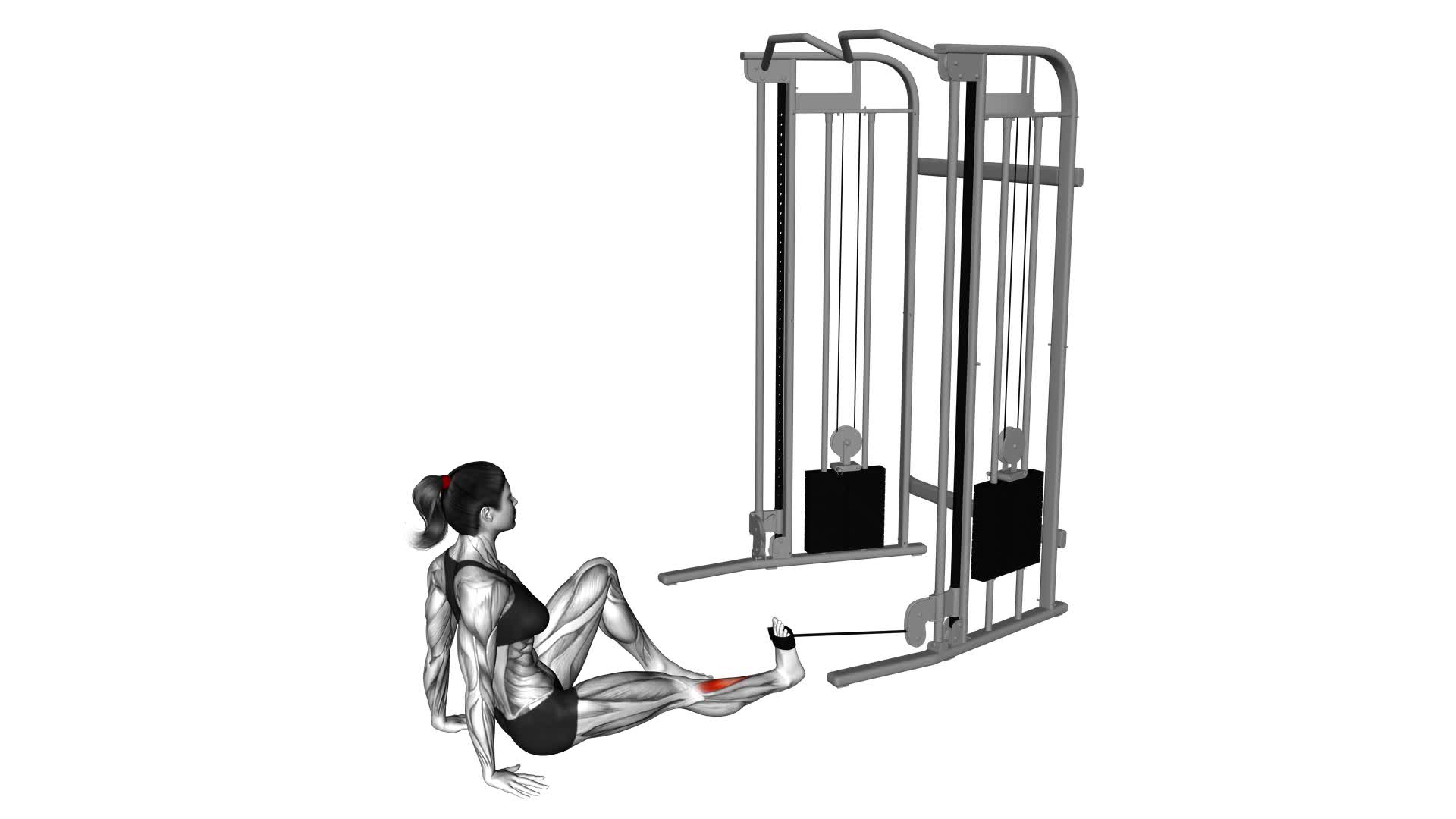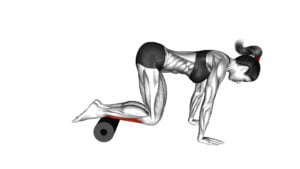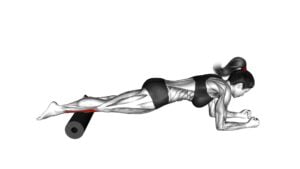Seated Tibialis Anterior Press (female) – Video Exercise Guide & Tips

Are you looking for an effective way to strengthen your tibialis anterior muscles? Look no further!
Watch This Exercise Video
In this article, we will guide you through the Seated Tibialis Anterior Press, a challenging exercise specifically designed for females.
With the help of a video exercise guide and useful tips, you'll learn the proper form and technique to maximize your results.
Get ready to take your workout to the next level and achieve stronger, more resilient lower legs.
Let's get started!
Key Takeaways
- The seated tibialis anterior press targets the tibialis anterior muscle and improves leg stability and prevents injuries.
- This exercise enhances ankle stability and athletic performance while also improving overall lower leg strength.
- The equipment needed for the exercise includes a seated calf raise machine, resistance band, dumbbell, chair, and footrests.
- It is important to maintain proper form and technique, gradually increase weight or resistance for progression, and try variations to challenge the tibialis anterior muscles.
Benefits of the Seated Tibialis Anterior Press
You'll experience several benefits from performing the Seated Tibialis Anterior Press exercise. This exercise specifically targets the tibialis anterior muscle, which is located on the front of your lower leg. By strengthening this muscle, you can improve your overall leg stability and prevent injuries.
One of the main benefits of the Seated Tibialis Anterior Press is the improvement in ankle stability. This exercise helps to strengthen the tibialis anterior muscle, which plays a crucial role in maintaining balance and stability in your ankles. By regularly performing this exercise, you can reduce the risk of ankle sprains and other related injuries.
Additionally, the Seated Tibialis Anterior Press can also enhance your athletic performance. Stronger tibialis anterior muscles allow for better control and power during activities that require quick changes in direction or explosive movements. This can greatly benefit athletes involved in sports such as soccer, basketball, and tennis.
Furthermore, this exercise can help to improve your overall lower leg strength. The tibialis anterior muscle is often overlooked in traditional leg exercises, but by incorporating the Seated Tibialis Anterior Press into your routine, you can ensure that you're targeting this muscle group effectively.
Equipment Needed for the Exercise
To perform the Seated Tibialis Anterior Press exercise, you'll need a few pieces of equipment. The primary equipment needed for this exercise is a seated calf raise machine. This machine typically consists of a seat, footrests, and weight plates for resistance. It's specifically designed to target the tibialis anterior muscle, which is located on the front of the lower leg.
If you're a beginner or don't have access to a seated calf raise machine, there are modifications you can make. One option is to use a resistance band. Simply sit on a chair with your feet flat on the ground and wrap the resistance band around the top of your foot. Then, press your foot against the band to create resistance as you lift your toes towards your shins.
Another modification is to use a dumbbell. Sit on a chair with your feet flat on the ground, hold a dumbbell on your thigh, and press the top of your foot against the dumbbell as you lift your toes towards your shins.
Proper Form and Technique
To perform the Seated Tibialis Anterior Press exercise with proper form and technique, you need to position yourself on the calf raise machine or use modifications like resistance bands or dumbbells. Proper form and technique are crucial to effectively target and strengthen the tibialis anterior muscle, which is located in the front of your lower leg.
One common mistake to avoid is using excessive weight, which can compromise your form and increase the risk of injury. Start with a weight that allows you to maintain control throughout the movement. Another mistake is allowing your heels to lift off the footrest or floor. Keep your feet planted firmly, ensuring that the movement is isolated to the tibialis anterior.
Progressions for the Seated Tibialis Anterior Press can be achieved by gradually increasing the weight or resistance used. This will challenge the muscle and promote further strength gains. Additionally, you can try performing the exercise on an unstable surface, such as a balance board or foam pad, to engage the stabilizing muscles even more.
Regressions can be helpful if you're new to this exercise or if you're experiencing any limitations. Instead of using the calf raise machine, you can use resistance bands or dumbbells to perform the exercise. This allows for more control and customization based on your fitness level and specific needs.
Remember to always consult with a qualified fitness professional before attempting new exercises, especially if you have any underlying health conditions or injuries.
Variations to Challenge Your Tibialis Anterior Muscles
Challenge your tibialis anterior muscles with these variations. Strengthening exercises for the tibialis anterior can help improve ankle stability and prevent injuries. Here are three different exercises that will target and challenge your tibialis anterior muscles:
- Single-leg Calf Raises: Stand on one leg with your toes on the edge of a step or a raised platform. Slowly lower your heel below the step, then raise it as high as possible, contracting the tibialis anterior. Repeat for the desired number of repetitions and then switch to the other leg.
- Resistance Band Dorsiflexion: Sit on a chair with a resistance band tied around the top of your foot. Keep your leg straight and pull your toes towards your body against the resistance of the band. Hold for a few seconds and release. Repeat for the desired number of repetitions and then switch to the other leg.
- Toe Taps: Sit on a chair and place a towel on the floor in front of you. With your heels on the ground, lift your toes and tap the towel with them. This exercise will engage the tibialis anterior and improve its strength.
By incorporating these exercises into your workout routine, you can effectively challenge your tibialis anterior muscles and improve their strength and stability.
Now, let's move on to the next section to learn some tips for a safe and effective workout.
Tips for a Safe and Effective Workout
To ensure a safe and effective workout, focus on your form and use proper technique. Injury prevention should be your top priority when engaging in any exercise routine. Here are some tips to help you stay safe and get the most out of your workout.
Firstly, always warm up before starting any exercise. This helps to prepare your muscles and joints for the workout ahead, reducing the risk of injury. A warm-up could include light cardio exercises like jogging or jumping jacks, followed by some dynamic stretches.
Next, listen to your body and modify your workout as needed. If you experience any pain or discomfort during an exercise, stop immediately and assess what might be causing it. You may need to adjust your form or choose an alternative exercise that's more suitable for your fitness level or any existing conditions you may have.
Furthermore, remember to maintain proper form throughout each exercise. Good form ensures that you're targeting the right muscles and reduces the strain on your joints. Poor form not only diminishes the effectiveness of the exercise but also increases the risk of injury.
Lastly, don't forget to cool down and stretch after your workout. This helps to prevent muscle soreness and aids in recovery.
Frequently Asked Questions
What Are Some Common Mistakes to Avoid While Performing the Seated Tibialis Anterior Press?
When performing the seated tibialis anterior press, it's important to be aware of common mistakes to avoid. Proper form is crucial for maximizing the effectiveness of this exercise.
Avoid rounding your back or hunching your shoulders, as this can put unnecessary strain on your spine. Additionally, make sure to keep your feet firmly planted on the footrest and avoid lifting your heels off the ground.
Remember to engage your tibialis anterior muscles and maintain a controlled and steady pace throughout the exercise.
How Often Should I Incorporate the Seated Tibialis Anterior Press Into My Workout Routine?
To properly incorporate the seated tibialis anterior press into your workout routine, you should aim to perform it at least 2-3 times per week.
This exercise targets the tibialis anterior muscles in your lower leg, which are often neglected.
By including this exercise regularly, you can improve your lower leg strength and stability.
Remember to also incorporate other lower leg exercises, such as calf raises and ankle dorsiflexion, to ensure a well-rounded lower leg workout.
Are There Any Specific Stretches or Warm-Up Exercises I Should Do Before Performing the Seated Tibialis Anterior Press?
Before performing the Seated Tibialis Anterior Press, it's important to do specific stretches and warm-up exercises. These exercises will help prepare your muscles and reduce the risk of injury.
Incorporating stretches that target the calves and ankle flexors can be beneficial.
Additionally, performing some light cardio exercises, like jogging or jumping jacks, can help increase blood flow to the muscles.
Remember to always warm up properly before starting any exercise routine to ensure maximum safety and effectiveness.
Can I Still Do the Seated Tibialis Anterior Press if I Have a Previous Ankle Injury?
If you have a previous ankle injury, it's important to consult with a healthcare professional before attempting the seated tibialis anterior press. They can assess your condition and determine if it's safe for you to perform this exercise. There may be alternative exercises or modifications that can be done to target the same muscle group without putting additional strain on your ankle.
The seated tibialis anterior press can be beneficial for ankle rehabilitation, but it should be approached with caution and under professional guidance.
How Long Does It Typically Take to See Results From Regularly Performing the Seated Tibialis Anterior Press?
To see results from regularly performing the seated tibialis anterior press, it typically takes time. The timing of results may vary depending on factors such as your current fitness level, consistency, and intensity of your workouts.
However, the benefits of this exercise include strengthening the tibialis anterior muscle, which can improve ankle stability and prevent injuries.
Conclusion
In conclusion, the seated tibialis anterior press is a highly effective exercise for strengthening the tibialis anterior muscles. By following proper form and technique, using the necessary equipment, and incorporating variations to challenge your muscles, you can ensure a safe and effective workout.
This exercise provides numerous benefits, such as improved balance, ankle stability, and injury prevention. Incorporating the seated tibialis anterior press into your routine can help enhance your overall lower body strength and performance.

Author
Years ago, the spark of my life’s passion ignited in my mind the moment I stepped into the local gym for the first time. The inaugural bead of perspiration, the initial endeavor, the very first surge of endorphins, and a sense of pride that washed over me post-workout marked the beginning of my deep-seated interest in strength sports, fitness, and sports nutrition. This very curiosity blossomed rapidly into a profound fascination, propelling me to earn a Master’s degree in Physical Education from the Academy of Physical Education in Krakow, followed by a Sports Manager diploma from the Jagiellonian University. My journey of growth led me to gain more specialized qualifications, such as being a certified personal trainer with a focus on sports dietetics, a lifeguard, and an instructor for wellness and corrective gymnastics. Theoretical knowledge paired seamlessly with practical experience, reinforcing my belief that the transformation of individuals under my guidance was also a reflection of my personal growth. This belief holds true even today. Each day, I strive to push the boundaries and explore new realms. These realms gently elevate me to greater heights. The unique combination of passion for my field and the continuous quest for growth fuels my drive to break new ground.



